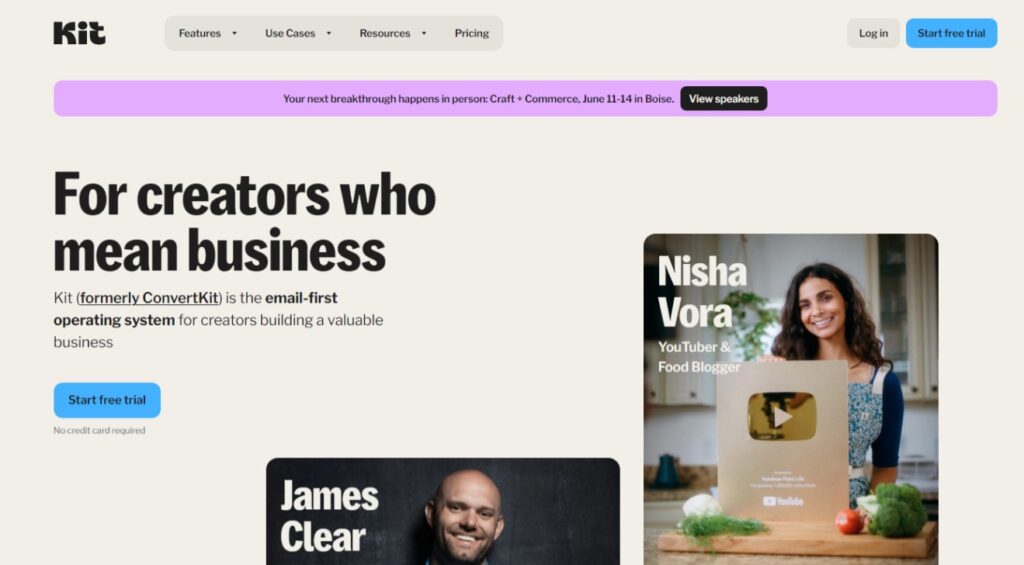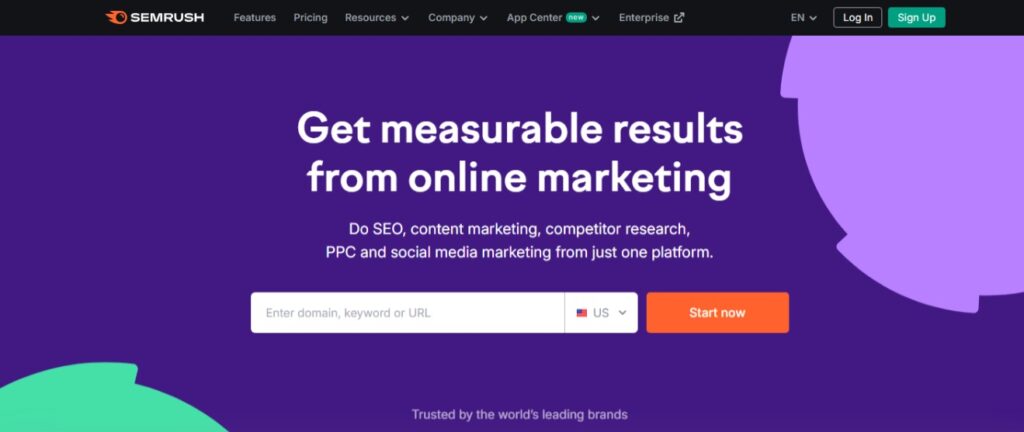Sam Altman. Oprah Winfrey. Mark Zuckerberg. Sheryl Sandberg.
We are now living in the era of personal brands where individuals have the power to make or break a company’s earnings.
Thought leadership is a powerful tool for generating revenue and driving business, if you can leverage the voice of your top experts and leaders online. The right thought leaders allow organizations to stay competitive, connect with their audience, and build trust. And can become thriving businesses in their own right.
To help you turn your top talent into thought leaders, here’s the step-by-step guide on how to become a thought leader in 2025.
Follow along or skip ahead:
- What makes a successful thought leader?
- 5 essential steps to become a thought leader
- Top tools and platforms to accelerate your thought leadership
- Common mistakes holding thought leaders back
What makes a successful thought leader?
Great thought leadership is a careful blend of new insights, original research, and powerful storytelling.
Like the perfect cocktail (or protein shake if that’s your thing) thought leadership is a combination of tasty ingredients that adds up to so much more than the sum of their parts, allowing businesses to connect with their audience and build a committed community of followers and fans.
Chances are, you have all the expertise you need in your team. There are potential thought leaders already in your ranks. Now it’s time to bring them into play and start sharing all that expertise, experience, and insights with your audience.
Here are 4 key ingredients for effective thought leadership in 2025.
Deep expertise in a niche
Good thought leadership starts with deep expertise. The best thought leaders have personal experience in their chosen field and they have insights, knowledge, and industry wisdom to share with the world.
To become a successful thought leader, you need to be able to step outside your day-to-day routine – your field of expertise – and see it with fresh eyes. What do you do everyday that people would be eager to learn about? What unique processes, methods, or insights do you have to share?
The best thought leaders are able to translate and transform their deep knowledge on a topic into a shareable format that other people can easily understand and connect with.
“Make it clear who you’re talking to. If you’re talking to everybody, you’re talking to nobody.”
– Brandy Woods-Smith, 7-Figure Thought Leader
Unique insights and research
To make the transition from an above average expert to a thought leader, you need to offer your audience something new.
The fastest way to become a thought leader is to provide your audience with original research or fresh, novel insights into a common problem they’re facing. That might be new data, surveys, case studies, or opinions and analysis from leaders in your niche. The point is, good thought leadership relies on novelty.
To catch your audience’s attention and keep it, you need to share insights that are disruptive, creative, and scroll-stopping. Time and time again.
“When we create content, we want it to be research-based, practical and based on best practices… We want to give them quick wins, because we believe that a series of quick wins will build that confidence to do some of the bigger things,”
– Brandy Woods-Smith, 7-Figure Thought Leader
Consistent, high-value content
What turns a subject matter expert into a thought leader? Their content.
At the heart of successful thought leadership is high-value content. Informative, high-quality, and consistent content is essential to become a thought leader who people follow, admire, and want to buy from.
Whether you produce podcasts, create videos, or write books, to become a respected thought leader, it’s essential that every piece of content you produce is jam-packed with value and relevant to your target audience.
To become a thought leader, you need to do more than just post on social media. You need to make people care about what you have to say.
“There is never too much you can give people… Some people say, ‘if you give them everything, what will they buy?’ Don’t worry about that. Give people enough to know that you’re valuable.”
– Brandy Woods-Smith, 7-Figure Thought Leader
Strong storytelling
The most successful thought leaders are also storytellers. Audiences are keen to hear the real, raw, and unfiltered experiences of industry leaders to help them develop an emotional connection to their content.
This means thought leaders who are able to add color and drama to their content by infusing it with personal stories, anecdotes, and examples from other industry experts are able to bring their words alive – and capture more attention from their audience.
“Be honest and vulnerable with your followers. Staying true to yourself is how you find your core audience.” – Cassandra Aarssen, 7-Figure Thought Leader
5 essential steps to become a thought leader
- Define your unique perspective
At its most basic, a thought leader is a person with deep expertise and a unique perspective on a specific topic. This means to become a thought leader, you need to define your unique perspective. And be prepared to share it.
Not sure where to start?
Here are some key questions to help you define your perspective:
- What expertise and experience do you have to share with your audience?
- What makes you uniquely qualified to speak on these issues?
- How can you offer a new, fresh take on specific topics?
- What makes your insights different from everyone else?
The process of becoming a thought leader is rarely linear. Defining your unique perspective can take time and it’s often a case of refining your message gradually, rather than overnight. It may also change over time, as you gather more data.
Where many thought leaders go wrong is reusing the same content hundreds of other thought leaders have shared. Rather than copying other thought leaders in your niche, try to think about what you bring to the table and the new, fresh expertise and ideas you can share.
To become a trusted voice in your industry, it’s not enough to just be an expert in your field. Subject matter experts need to find a unique and fresh perspective on key topics and develop a clear stance or opinion.
This might include:
- Original research
- Case studies and success stories
- Interviews with other industry experts
- Sharing new studies or industry updates
- Fresh content formats e.g. video or infographics
Think of ways to offer your audience something they haven’t seen before, whether it’s a new opinion, new case study, or new data.
Aligning with your business
For businesses looking to establish their corporate leaders and subject matter experts as thought leaders, your unique perspective will be tied to your business and the products or services you currently offer.
In this case, work on defining your long-term, overarching goals so you can make sure your individual leaders’ thought leadership aligns with your business goals.
For example, Tim Suolo, Ahrefs’ Chief Marketing Officer and Ryan Law, Director of Content Marketing at Ahrefs, have built their reputations as thought leaders in the field of SEO and content marketing, creating informative content that directly ties back to Ahrefs’ suite of SEO tools. Their success as individual thought leaders contributes to the success of the Ahrefs brand overall.
- Grow your engaged audience
Your existing audience is your best asset for growing your audience. The more you can boost engagement, the more your content will be shared and seen by new eyes.
But to truly utilize your audience as a thought leader, you need to make sure you have a way to speak to them directly. Outside your regular social media channels.
This might include:
- Building an email list
- Growing a private community
- Creating educational courses
By converting passive followers into subscribers or community members, you can build stronger ties with your audience and grow your influence.
These channels allow you to establish a direct link to your audience where you can spark conversations, gather feedback, and share your offer, as well as making sure you’re not at the mercy of any sudden, unforeseen changes on your social media channels.
Building human connections
At the heart of successful thought leadership is a human element. Rather than a faceless corporate brand, thought leaders give big businesses a human side. People connect with people.
To grow your audience and become a successful thought leader with a thriving following, you need to be brave and show your human side in your content.
This might include:
- Sharing personal stories
- Talking about your past experiences
- Being open about challenges or barriers you’ve faced
- Sharing how you achieved a certain transformation or result
The more you can share personal experiences, the more you can build an emotional connection with your audience and create a loyal community of followers. Nobody’s perfect and your imperfections are your secret weapon to make your content stand out.
- Create and publish high-value content
High-quality content is the key to becoming a thought leader. In fact, if you’re not creating valuable content or giving people a reason to follow you, you’re probably not going to grow your audience.
That means you need to be sharing content that:
- Builds trust
- Establishes authority
- Feels human
- Creates a connection with your audience
For example, rather than sharing a generic, formatted post that you lifted from a template, try adding original research, an anecdote, or an insight from a trusted expert in your industry.
Aim to go above and beyond what your audience has seen, read, or heard before and deliver content that exceeds their expectations.
Long-form vs. short-form content
Long-form content allows you to clearly state your ideas, methods, and strategies in a comprehensive format. This gives your audience a chance to learn about your unique perspective in-depth – and apply what they learn in their own life or business.
Long-form content is also a simple way to monetize your influence. You can choose to give your content away for free or sell it as a product in its own right alongside your core products and services.
Here are some of the best long-form content types for thought leadership.
Books
Many of the most successful thought leaders have written books on their area of expertise.
What makes books so effective for thought leadership? Well, thanks to their long-form format – usually ranging from 20,000 to 60,000 words – books are a chance for you to share your expert knowledge in detail, clearly outlining your reasoning and methods.
Books are also a way for your audience to spend more time with you. Whether they read it cover-to-cover or skim, your book is a window onto your unique perspectives and ideas. This builds instant authority and credibility in the eyes of your audience and establishes an emotional connection with your brand. A book lets your audience peer into your brain.
Books can also be a useful tool for winning new clients and customers. If you can provide prospective clients with a book outlining your unique perspective and methods, it’s another way for them to evaluate your expertise and see if you’re the right fit for them.
Articles and blog posts
Another effective channel for sharing your ideas is articles and blog posts. Posting long-form content online gives you the opportunity to share your thoughts and ideas with a wider audience.
Articles can also provide a boost for your website’s SEO, helping your content show up in organic searches and giving you another channel of owned media to reach your target audience.
The more you can share your views, experiences, and insights online, the more value you can provide to your audience. And the more you can build your reputation as a trusted thought leader in your field.
Newsletters and email
Like articles, newsletters are a form of shareable content that allows you to deep dive into a specific topic or idea. Email content gives you the chance to speak directly to your audience by showing up in their inboxes week-on-week, providing tips, tricks, guidance, and education that keeps you top of mind.
The more value you can pack into your newsletter, the more your audience will look out for your content each week or month, and the more receptive they’re likely to be to future offers or products on the horizon.
Webinars
Webinars and podcasts are a great way to build your reputation as a thought leader by providing your audience with a chance to spend time with you ‘face-to-face’.
By sharing your ideas and processes in a webinar format, your audience has a chance to ask questions real-time and get direct responses. This adds an extra layer of personalization to your content.
What’s more, webinars are a great way to build your reputation by collaborating with other thought leaders, experts, and brands. Helping to boost your authority and credibility. And if you can partner up with established guests in your industry – or in a niche that’s relevant to your target audience – you can provide even more value with every event.
Case studies
Why do people follow thought leaders? To learn something new and get solutions to help solve the problems they’re currently facing.
Case studies are a powerful tool for thought leadership as they provide a detailed guide that outlines how another business or individual achieved a specific transformation.
By breaking down the process into a step-by-step, blow-by-blow case study, your audience gets all the juicy details – and lots of ideas for how they can achieve the same results.
Short-form content and content repurposing
Of course, to be a thought leader you don’t necessarily need to create long-form content. Short-form content can be just as powerful as long-form, providing a bite-sized, snackable way for your audience to consume your content and get your ideas and opinions.
To make short-form content work for you, it’s a good idea to create a plan for repurposing your content in different ways. Why does this work? Only a fraction of your audience will see your content when you post it online, so repurposing and resharing content gives your followers a chance to catch key concepts again.
For example, one LinkedIn text post could become:
- A carousel
- A series of short-form videos
- An infographic
- A checklist or template
Even sharing the same text post with a different hook or formatting can get wildly different engagement. The best thought leaders are constantly remixing their ideas in different ways.
AI thought leadership content
Today, there are plenty of AI-powered tools to help you create, repurpose, and distribute content, making it easier than ever to build your status as a thought leader.
For example, you can use AI-tools to:
- Brainstorm content ideas
- Create outlines or first drafts
- Edit or repurpose videos
- Transcribe video content
- Translate your videos or text
If you’re using AI-driven tools, make sure you edit any output to ensure it aligns with your thought leadership positioning and your brand voice – and feels like you.
As well as publishing your own high-quality content, you also need to be building your authority by sharing your ideas across other channels. To increase your credibility in the eyes of your audience, get friendly with well-respected brands, businesses, and publications.
Here are some ways to grow your authority – and extend your reach beyond your own content to conquer the world.
Guest podcast appearances
Podcast appearances are a powerful way to share your expertise with a wider audience – and increase your authority and credibility in the process.
While you won’t necessarily start out as a guest on The Diary Of A CEO, there are plenty of smaller podcasts who are eager for guests with a fresh perspective or process to share.
To get your first podcast appearances, reach out to podcast creators and share your area of expertise and how you can help their audience. Tailor your pitch to the podcast depending on their format, audience, or angle.
In your pitch, make sure you share key details such as:
- Who you are
- What you do
- Your area of expertise
- Relevant achievements
- Your top content
- Your podcast topic idea
The more podcasts you can do, the more you can build your reputation and authority. And as you gain more experience and credibility, you can level up and win guest appearances on bigger and more popular podcasts.
Speaking engagements
One of the fastest ways to build visibility and credibility is to get speaking engagements at conferences and events in your niche.
If you’re still building your reputation, you can pay to secure speaking engagements in the early days of your thought leadership journey. For example, paying to sponsor smaller conferences in your niche can allow you to secure speaking engagements and get in front of your audience.
There are also plenty of opportunities to apply for speaking opportunities for free – the more you can demonstrate your influence as a thought leader, the higher your chance of being accepted as a speaker.
And if you get good enough and build your reputation, you can transition to getting paid to speak at industry events.
Top tip: Get a recording of any speaking engagements you do to share snippets via your social media, email, and website – that’s a whole bank of valuable content you can use.
Features in top-tier media and industry publications
Getting features in media and industry publications is another top method for building credibility and authority in the eyes of your target audience.
If someone Googles your name and sees your feature in the Wall Street Journal or Forbes as the first result, for example, that’s very likely to boost your reputation in their eyes.
Third-party publications strengthen your position as an expert in your field, helping to increase trust with prospective clients, collaborators, and investors. The more coverage you can get in trusted publications, the more you position your insights, your product, or your service as the go-to solution in your niche.
For example, snagging features in:
- Industry-specific publications
- Trade magazines
- Mainstream media
- Academic publications
- High authority websites
You can either contribute as a guest writer or get featured in articles and blogs as an expert. When you’re approaching media and industry publications, be clear about your expertise, experience, and previous published content.
Top tip: Media features from high-authority websites like The New York Times or Forbes that include backlinks to your website can also boost your SEO and digital presence.
Winning awards and industry recognition
If you can get awards and industry recognition under your belt, that’s a huge boost for your reputation and credibility. Awards show you’re recognized as the best in your field.
Awards and industry recognition can help you strengthen future speaking applications, open up new PR and media opportunities, and establish you as an expert in the eyes of prospective customers.
To get started, look out for relevant awards in your industry. Most awards require a detailed application to demonstrate why you’re eligible for the award and highlight your expertise and standout work in your industry. Make sure you meet the requirements for the award before taking the time to apply.
If you manage to bag any awards, add them to your website, social media, and email content to increase your credibility in the eyes of your audience.
There are several ways to monetize your thought leadership to drive revenue. And turn your hard won credibility and influence into dollars.
To maximize the revenue from your thought leadership, consider creating a suite of offers to target different segments of your audience. If you can create an ecosystem of products and services, prospective buyers can choose how they want to engage with you and your business.
Here are a few top strategies to convert influence into revenue:
Online courses and memberships
As a thought leader, you have a wealth of expertise to share with your audience, so it’s easy to convert that knowledge into online learning content. Online courses and memberships create a formalized space for your audience to learn your ideas, methods, and processes in-depth and in an actionable format.
For many thought leaders, online courses are a natural progression from posting or sharing content online. Chances are, much of your course content has already been written. All you need to do is repurpose it.
Look back at all the content you’ve created so far in your thought leadership journey, including:
- Blog posts
- Podcasts
- Videos
- Social media posts
Collate all that information into broad topics or categories and then use this to build your course structure – or better yet, break up your content into several courses.
Memberships allow you to generate recurring revenue from your digital learning content, producing a consistent, predictable monthly income. You can offer several membership tiers with the higher-priced premium tiers gaining wider access to your content and expertise.
These monetization strategies work really well because they’re scalable. There is really no limit to the number of online courses you can sell and once you’ve created your course, you can leave it to run and run.
Consulting and high-ticket offers
Within the pool of your audience who currently consume your content, there is very likely to be a top 1% who have higher budgets to work with. And the more of this audience segment you can attract and convert, the more revenue you can drive to your business.
This is where your higher ticket offers come in. To maximize the revenue from your thought leadership, create an offer suite of premium products or services that provide targeted expertise.
For example, premium offers might include:
- Group coaching and cohorts
- Premium courses
- One-on-one coaching
- Consulting
As a general rule, the offers that require more time and attention from you should be priced higher. For example, one-to-one coaching services could be your premium offer, reserved for a small fraction of your audience who are willing to pay a higher fee for direct, personalized access to your knowledge and expertise.
Corporate partnerships and sponsorships
If you’re creating thought leadership content regularly, you can add an extra revenue stream through corporate partnerships and sponsorships.
For example, if you have a podcast, sell sponsorship opportunities to relevant brands who share your audience to generate recurring revenue. Sponsorships can cover the cost of your podcast production – and generate a profit too.
In fact, you can start selling sponsorships before you produce a single episode of your podcast. Approach brands and outline your podcast concept and ask if they’d like to sponsor your podcast for a discount – if you can create a convincing pitch and demonstrate you have high quality guests who’ll be coming on the show, you can secure sponsorships from day one.
Collaborate with other thought leaders and brands
The fastest way to scale your influence and become known as a key thought leader? Collaborations.
Collaborations with other brands give you the opportunity to maximize your exposure and influence in a way that could take years for you to achieve alone.
To take a simple example, rather than trying to build a successful podcast with a strong following, you can simply partner with existing podcast hosts to share your expertise and knowledge with their audience.
Partnering up with businesses that have a larger or wider audience can help you reach new prospective customers and build your brand awareness. And collaborating with businesses or experts who have a different skill set to you can open up more opportunities for you to enhance your products and services.
There’s really no limit to the range or type of collaborations you can do. If you can be strategic in your partnerships, you can significantly increase your influence and revenue with just one collaboration.
Top tools and platforms to accelerate your thought leadership
There are a wide range of tools and platforms tailored to helping experts become thought leaders. Here are 6 of the best tools you need in your toolkit.
Thinkific: Monetize your expertise through digital learning products

Thinkific is tailored to helping thought leaders create digital learning products with ease. The platform is built to be extra user-friendly, so you can start monetizing your expertise right away.
Rather than struggling with hard-to-use tools, Thinkific is intuitive and extra simple, so you can get your first digital product up and running in less than a day.
Create a wide range of digital products, including:
- Online courses
- Communities
- Digital downloads
- Memberships
- Coaching and webinars
Build a community, roll-out an online course, and host webinars all within the same platform. It’s as easy as that. Plus with built-in marketing tools, you can publicize and promote your content with Thinkific too.
“We all have a gift that someone needs. Don’t let technology, imposter syndrome, or other limiting beliefs scare you. Just put yourself out there and get started.” – Amanda Schoenberg, Thinkific user
LinkedIn: Build authority through content and networking

The power of LinkedIn for thought leadership is no secret. LinkedIn is the leading professional social platform online with over 1 billion members from 200 countries and regions worldwide.
LinkedIn is all about connections and the more you can engage with your audience, the better. By sharing your unique insights and starting discussions on the platform, you can generate a loyal following online and quickly grow your influence.
There are a wide range of ways to share your insights on LinkedIn, including:
- Text and image posts
- Short-form videos
- Collaborative articles
- Blogs
- Comments
As well as publishing your thought leadership content, LinkedIn is also an ideal tool for connecting with industry experts and decision-makers, be it podcast hosts, event organizers, or prospective clients. To maximize your success on LinkedIn, use a combination of content and direct messaging to connect with your ideal audience and boost your reputation.
Substack: Publish and share thought leadership articles

Substack allows you to publish content online – and build your email list at the same time.
One of the top benefits of Substack is its existing audience of readers, subscribers, and writers, thanks to its established reputation. Substack is tailored to thought leaders who don’t necessarily have a big content team supporting them, providing easy-to-use tools and a simple user interface to make publishing content as straightforward as possible.
Some top Substack features for thought leaders are:
- Social media integrations
- Easy sharing tools
- Email template customization
- Email analytics
- Integrated comment sections
Substack has steadily grown into a more social platform, launching a range of features aimed at helping thought leaders connect with their audience and other writers, including discussion threads, recommendations, and direct messages (DMs).
This email-first platform also includes built-in tools for generating subscription revenue from your email content – but if you’re looking to effectively monetize your thought leadership, tailor-made platforms like Thinkific offer more robust tools for maximizing your income.
Kit: Build and monetize your email list

Tailored for thought leaders, Kit (formerly ConvertKit) is designed to help you build an email list and convert your social media followers into subscribers and customers.
Kit caters to thought leaders at every stage of their journey, ranging from micro-influencers to leading industry experts.
Top features include:
- Email newsletters
- Customizable landing pages
- Audience segmentation
- Automated customer journeys
For example, Justin Welsh used Kit’s automation tools to help him earn $1.5 million in 6 days on a course launch. By taking advantage of personalization features that allow users to tag and segment their clients and leads, he was able to automatically send targeted content based on their specific needs and boost engagement.
“Kit gets complex automations and understands personalization and customization, allowing me to tell the right story to the right person so they’re more likely to buy.” – Justin Welsh, LinkedIn entrepreneur
CoSchedule: Plan and schedule social media content

An AI-driven content marketing calendar designed to be a single source of truth for your content, CoSchedule lets you map out your thought leadership content ahead of time. So you can stay organized and stay consistent.
Take advantage of the 1600+ AI marketing prompts to help you craft your social copy. And use CoSchedule calendars to help you keep track of all your content in one place, including social media calendars and content calendars.
Create and schedule content ahead of time. Coordinate content across teams for a consistent brand message and easy collaborations. And take advantage of the drag-and-drop scheduling tool to stay flexible as your thought leadership plan changes.
SEMrush: Content planning and SEO

If you’re creating long-form content, SEO and content marketing platforms like SEMrush give you the tools you need to tailor your content to show up in searches.
SEMrush is ideal for thought leadership with top features like keyword research tools, backlink analysis, and an SEO writing assistant.
This platform can help you:
- Choose content topics
- Find target keywords
- Conduct competitor analysis
- Identify guest posting opportunities
The SEMrush topic research tool surfaces content ideas to help you create content that connects with your target audience, including the questions being asked online and popular topics trending online.
Get your thought leadership content seen by more people – and drive more traffic to your website.
Common mistakes holding thought leaders back
If you’re looking to build a reputation for thought leadership in your business, there are some potential pitfalls you need to watch out for. Here are 4 common mistakes.
Not niching down enough
To build a reputation as a thought leader, you need to become known for a specific perspective or point-of-view. Trying to please everyone is not going to cut it. If you try to speak to everyone, you’re going to resonate with no one.
The most successful thought leaders have a clear message and communicate their position on key topics and debates in their industry with confidence. The result? People know you for your perspective and they want to follow you to hear more.
Rather than offering a watered down approach to thought leadership, the strongest thought leaders hold a strong position and aren’t afraid to turn away some people who aren’t the right fit in the process.
Publishing inconsistent content
Where many thought leaders go wrong is in trying to go too broad with their message or talk about too many topics. To build a successful thought leadership brand, you need to be consistent in your content and brand message.
That means showing up every day talking about the same topics over and over. And respinning and remixing your message in new and inventive ways to keep your content interesting.
If you can bring consistency to your content, you can become instantly recognizable. And as soon as your audience catches a glimpse of your content, they know who is talking, what message you’re conveying, and what values and views you stand for.
Consistency looks like:
- Consistent content and standpoint
- Consistent style and delivery
- Consistent tone of voice
- Consistent brand colors
Anyone clicking on your LinkedIn profile or discovering your social media posts on any given day should be able to understand instantly what you do and where your expertise lies. That means repetition, repetition, repetition.
Lack of a clear monetization strategy
It takes a lot of hard work to become a thought leader. To help you make the most of that hard work and drive meaningful revenue to your business, you need to have a clear monetization strategy mapped out. Ideally before you start.
Where many brands go wrong is in watering down the strength of their thought leadership by pushing products or services that aren’t the right fit or don’t deliver value to their audience.
This is especially true when it comes to collaborations, partnerships, and sponsorships. Ensure that any business you work with aligns with your brand values, your mission, and your stance as a thought leader to make sure you don’t lose the respect of your audience in the process.
Rather than selling something just for the sake of it, think carefully about how your team will monetize your thought leadership in advance for best results.
Relying only on social media
Social media is a fickle friend. While your banks of social media followers might seem like a solid, permanent community of loyal fans, your status on your chosen social media platforms is not guaranteed.
This is where building owned platforms – such as an email list or community – is so important. If you can convert your social media followers into subscribers, members, or customers, you’re prepared for anything that comes your way. Be it algorithm changes, a blocked or deleted account, or even platform outages.
Becoming a Thought Leader is a long-term strategy for your brand
The journey to becoming a thought leader is rarely an overnight success story. But for many businesses, it’s well worth the investment.
Thought leadership is about showing up consistently, owning your perspective, and building credibility over time. The best experts combine thought leadership with a clear business strategy, allowing them to build both influence and scalable revenue. By being clear on your monetization strategy, you can ensure your hard work moves the needle on business growth and builds a thriving business long-term.
To help you start monetizing your business’ thought leadership right away, try Thinkific for free and build the high-quality digital products your audience wants and needs.





